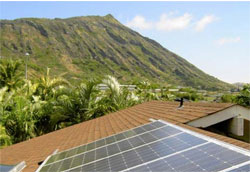With almost unparalleled wind, solar, bioenergy, wave and geothermal resources – and the highest electricity rates in the US – Hawaii is a logical place to test new clean energy ideas.
That’s why the U.S. Navy just put $30 million into a local program, called Energy Excelerator, that is funding startups to bring these technologies to market.
The investment falls under the Office of Naval Research (ONR) Asia-Pacific Technology and Education Program. The intent is to help reduce the Navy and Marine Corps’ dependence on fossil fuels.
This is a particularly big deal in Hawaii, where almost all oil is imported to serve the state’s power and energy needs.
"In the modern era, technological breakthroughs offer unprecedented opportunities to move toward diversified energy sources," says Richard Carlin, director of ONR’s Sea Warfare and Weapons Department. "It’s vital for our sailors and marines, and the nation, to discover and develop new sustainable sources of energy – as well as dramatically improve the way we manage energy."
The Energy Excelerator program provides seed funding of $30,000 to $100,000 to companies working on projects across a broad spectrum: including technology to facilitate the grid integration of renewable energy sources like solar and wind; energy storage breakthroughs; and clean transportation.
Companies that aren’t based in the region can also get grants up to $1 million for pilot projects, provided the company can raise $500,000 in matching funds.
So far, the program has a good track record: the 17 companies in its portfolio have raised more than $40 million in follow-up funding over the past three years and generated $18 million in revenue. They represent a range of technologies from micro-concentrating solar collectors (Sopogy Inc.) to algae biofuels (Kuehnle Agrosystems), smart energy storage that helps smooth solar load variability (Hnu Energy) and electric vehicle charging infrastructure (Opconnect).
"Partnerships are vital if we’re going to reach our energy goals," says Carlin. "With this program that helps small companies bring their products out of the lab and into the market, we’re supporting a forward-thinking organization that can make a significant contribution to future energy needs."
Energy Excelerator got started with $8 million from the Department of Energy; the Navy’s infusion more than triples the resources that it’s made available during the past three years. Besides funding, the program helps connect startups with potential customers, including utilities, businesses and military bases.
“Cleantech is struggling in the venture world," Energy Excelerator’s Senior Manager Dawn Lippert told TechCrunch. "A lot of energy companies in cleantech are hungry for this program. They’re coming to Hawaii to get into a market, and that’s what we do. Working in this market with a lot of players, and we help them find early customers. In the general world of clean tech and energy, this is a really bright spot.”
Vast Renewable Energy Potential
Hawaii’s long-term solar potential is second only to California, and it already gets 14% of its energy from renewables, placing it among the top 6 states for solar. It’s making quick progress – as recently as 2010, it still imported about 94% of its energy, according to the U.S. Energy Information Agency. The state’s goal is to use 40% clean energy by 2030.

During 2012, Hawaii installed 109 megawatts (MW) of solar PV under the utility’s progressive solar policy and it could become the second largest market this year, reports the Solar Energy Industries Association. The amount of solar on Hawaii’s electric grids has nearly doubled every year since 2008.
The state is also moving aggressively to cut energy demand by 30% by 2030. As of July, Hawaii offers energy savings performance contracts with a goal of doubling the efficiency of state and Honolulu County buildings by 2015.
Read our article, Solar’s Growing Role in the US Military.
Learn more about the Energy Excelerator program, which is accepting applications until Sept. 27:

